The Arctic nesting season is short in duration, and the sandpipers that nest in the far north don’t even use the full potential of the summer weather, 24-hours of sunlight each day, and abundant foods. Adults of some species leave soon after nestlings hatch; some females may only spend a few days with hatchlings before leaving them to rely on innate instincts to lead them on their migration south – after feeding, growing, maturing, and learning to fly on their own.

The adult males act like different birds when they are in the Arctic – doing things we never see in areas to the south. Males are singing, performing flight displays, establishing territories, and mating with females – only to return to southern latitudes to act as if none of those behaviors transpired – same ‘ole birds down here. But almost as soon as they arrive in the Lower 48 States, adult sandpipers begin molting from the most colorful and bold patterns of their alternate plumage to their regular ‘ole basic plumage that will protect them and permit them to fly until next spring when they molt back into alternate plumage.
That’s what the sandpipers are doing now – arriving, and molting. Using one of the more colorful Arctic-nesting sandpipers as an example, the first Long-billed Dowitchers arrive in Dakota covered in a beautifully colorful rufous and brown alternate (breeding) plumage, only to begin molting into their drab gray and white basic (winter) plumage. Later arriving dowitchers may already have molted in southern Canada, already covered in their basic gray plumage.
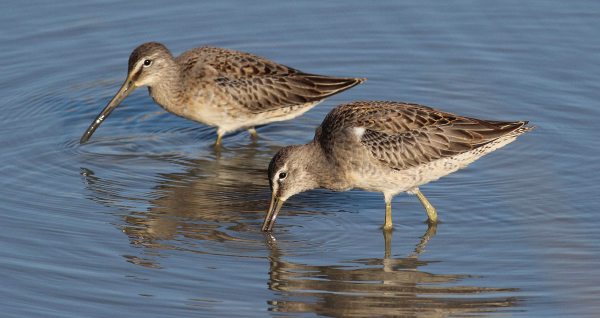
Photographing birds often leads us to learn more about a species we encounter with our camera. When sharing photographs, it’s really not enough to simply identify the species and share that with other people. We birders want to dig into these interesting birds: Where do they nest? Where do the winter? What are their outstanding behaviors? With that in mind, let’s take a closer look at 2 of the most obvious sandpipers I’ve encountered and photographed this week: Long-billed Dowitchers and Pectoral Sandpipers.
Long-billed Dowitchers form strong pair bonds in advance of nesting along the North Slope of western Canada and Alaska, and both adults incubate the eggs in a nest built on the ground among low tundra plants. Hatchlings are precocial and can walk and feed on their own within hours after hatching. The female leaves raising hatchlings to the male a few days after the young hatch, but the male stays with the hatchlings until they fledge, or just before fledging. Fledglings band together at coastal marshes along the North Slope before migrating south.
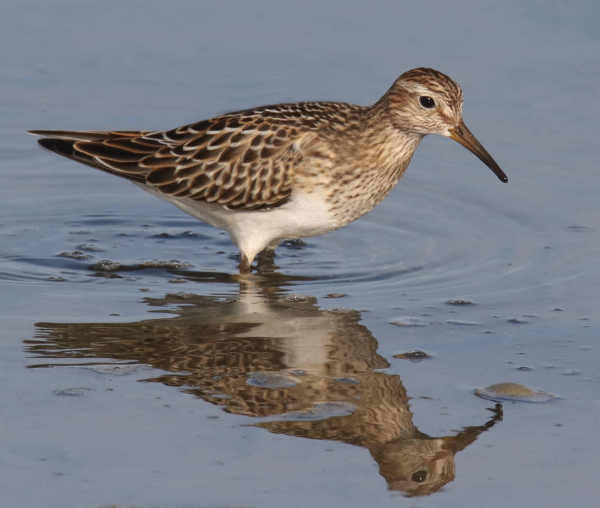
Adult Long-billed Dowitchers migrate south after the incubation period (females) and fledging period (males), but fledglings remain in the Arctic an additional 1 to 2 months. While it may seem the Canadian populations would be most likely to migrate into the Great Plains, banding information ha revealed that Long-billed Dowitchers that nest on the North Slope of Alaska were encountered in Kansas and Louisiana. Wintering populations primarily range from the southern parts of the southern tier of states, and throughout Mexico.
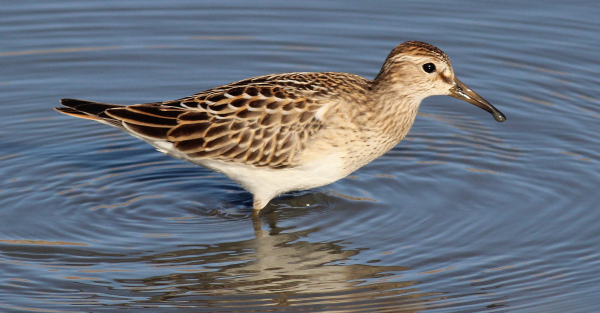
Pectoral Sandpipers nest in the Arctic along the North Slope of western Canada and islands even farther north, the North Slope of Alaska, the Bering Sea coastal areas, and the North Slope of Siberia across east to the Tamir Peninsula. Most Pectoral Sandpipers migrate through central North America – even most of the Siberian nesters – to eventually winter in suitable areas across the southern half of South America. During the Arctic nesting period, male Pectoral Sandpipers begin leaving their territories before eggs hatch, and females leave when the precocial hatchlings are 10 to 20 days old. Fledglings leave the nesting territory 4 to 6 weeks after hatching, forming groups with other broods and some adult females at feeding areas.
Photo Sessions
Studying photographs of birds taken in the field can be especially helpful in identifying similar-looking sandpiper species while providing more familiarity with individual species – especially as shorebirds are beginning to molt. Today’s digital photographs can be so detailed that by magnifying photos on computer screens we can study details of individual birds’ plumage, including colors of plumage tracts and even individual feathers, along with bill length and shape, leg color, wing to tail ratios, and more. This kind of photo study can help to make you a better birder, and help remove some frustration in trying to identify different species of small sandpipers you encounter.
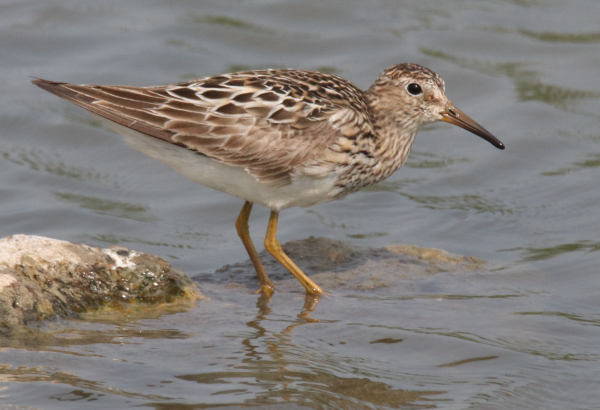
My shorebird photo tips include finding a place where you can park and use your vehicle as a blind, which has been especially successful at Charo Marsh, 20 minutes away from my office. If you live near a hiking trail that borders a wetland where shorebirds congregate, or a boardwalk that permits you to get close to shorebird habitat on foot, that’s often all the better. Time your photography for morning or afternoon periods when the sun is at your back with the birds in front of you. And take lots of photos, partly because it’s fun, but also so you document different species and different plumage types – and to study the birds in digital images magnified on your computer screen.
It's always good to spend a little extra time as you are photographing shorebirds too; I often have new birds arrive, or existing birds begin new activities, which provides new photo potential and added focus on birds before you. Case in point, late Monday afternoon I spent a half-hour photographing individuals and groups of the 9 Long-billed Dowitchers assembled at Charo Marsh. Before leaving I scanned the shoreline with binoculars and sighted a Semipalmated Plover. In response, I backed up to get into position in case the plover moved into the open, but suddenly a surprise Solitary Sandpiper appeared on the edge of the flock of dowitchers. I pulled forward again with hope of photographing what I believe was my first sighting of this species at Charo Marsh, and a species I have rarely seen – anywhere.
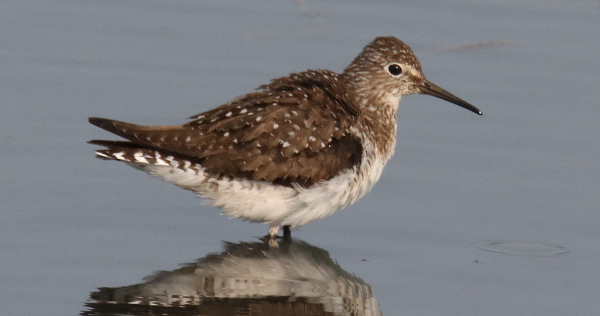
After taking a couple documentary photos, the ‘rare’ sandpiper began a lively bathing session that included frenzied flights for only a foot or 2 before diving into the shallow water and repeating the process. Those wild antics were followed by more normalized preening. But wait, this sandpiper was not so solitary, as a second Solitary Sandpiper mysteriously appeared just a few feet away, as did a Pectoral Sandpiper – where were these birds coming from? A minute later the 2 Solitary Sandpipers called to one another and took flight; but what luck to be on hand for the short period I could photograph them. The Solitary Sandpiper provided a memorable portrait as it ruffled its plumage slightly after its spirited bathing session, and I share that photo with you here, just hours after taking the image – my best of the “Solitary” species. Enjoy your August birding days!
Article and Photographs by Paul Konrad
Share your bird photos and birding experiences at editorstbw2@gmail.com